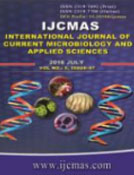


 National Academy of Agricultural Sciences (NAAS)
National Academy of Agricultural Sciences (NAAS)

|
PRINT ISSN : 2319-7692
Online ISSN : 2319-7706 Issues : 12 per year Publisher : Excellent Publishers Email : editorijcmas@gmail.com / submit@ijcmas.com Editor-in-chief: Dr.M.Prakash Index Copernicus ICV 2018: 95.39 NAAS RATING 2020: 5.38 |
Phytoremediation that uses various types of plants to remove, transfer, stabilize and/or degrade contaminants from the soil-water environment is an emerging technology. This offers an attractive, environmental friendly, cost effective and safe alternative to conventional clean up techniques, by utilizing the ability of certain plant species to remediate metal polluted soil-water, thus keeping them out of the food chain. The present paper describes the potential of Helianthus annuus for remediation of heavy metals such as cadmium, lead and zinc from aquatic and mycorrhizal soil environment. Phytoremediation of heavy metals by H. annuus shows that the plants have remediated 79-90% Cd, 77-89% Pb and 81-92% Zn at 5-50 ppm concentrations from the aquatic environment. The metal accumulation efficiency of the plant increased with increasing metal concentration and exposure period. H. annuus has been found to have high biomass at varying exposure concentrations which resulted in increased uptake of heavy metals. Maximum levels of zinc, cadmium and lead were observed in roots followed by shoots. A pot culture experiment was carried out to study the uptake of heavy metals, in particular Cd, Pb and Zn from mycorrhizal soil by H. annuus. The uptake and bioaccumulation of metals was increased as the concentrations of the metals increased in mycorrhizal soil. The bioaccumulation of metals in roots was increased upto 35,600 μg gm-1 - Cd, 32,473 μg gm-1 -Pb and 34,535 μg gm-1 -Zn; whereas uptake in shoots was found 8,194 μg gm-1 Cd, 16,227 μg gm-1 Pb and 19,040 μg gm-1 Zn at higher metal concentration (50 ppm). The accumulation of metals was recorded highest in roots of the plant followed by shoots. The result indicates that mycorrhizosphere has enhanced the growth and uptake potential of sunflower in respect of Cd, Pb and Zn at varying concentrations viz. 5, 10, 20 and 50 ppm. The research findings have proved the potential of H. annuus for remediation of metals from contaminated soil-water environment.
 |
 |
 |
 |
 |